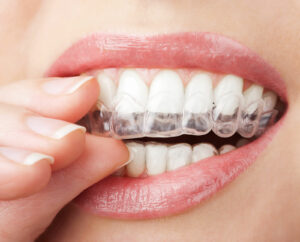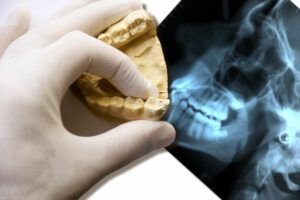Braces aren’t just for kids. Plenty of adults are looking into orthodontics later in life. But how can you tell if getting braces might be the right option for you or your child?

Your Teeth Are Visibly Crooked or Overcrowded
This is the most obvious sign that you may need braces. If your teeth are significantly crooked or if they crowd together too much, it may be difficult to clean them properly. This could lead to an increased risk of tooth decay and gum disease.
Your Teeth Don’t Fit Together Properly When You Bite
If your upper and lower teeth don’t come together evenly when you bite, it’s called a malocclusion or bad bite.
This can be caused by teeth that are too far forward or backward, crowded teeth or a misaligned jaw.
A bad bite can also cause pain in your jaw joint (TMJ).
You Have Excessive Gap Teeth
Gaps between your teeth, also called diastema, can be caused by thumb sucking habits as a child, genetics or missing teeth. Gaps can make your teeth look larger than they are and may cause problems with eating and speaking.
You Have Difficulty Flossing or Brushing around Crooked Teeth
If it’s hard for you to floss or brush your teeth because they’re crowded or in the way, it means plaque and tartar can build up, which can lead to tooth decay and gum disease.
You Have Teeth that are Worn Down
Wearing down of the teeth can be caused by clenching or grinding your teeth (bruxism), tooth structure abnormalities or acid reflux. Wearing down can make your teeth look shorter and can cause pain in your jaw joint (TMJ).
You Suffer from Jaw Pain
If you have pain in your jaw or around your ears, it could be TMJ. This is a common condition that occurs when your bite is off or your teeth don’t line up correctly.
You Frequently Bite Your Tongue or Cut Your Tongue On Your Teeth
If you frequently bite your tongue or find that you are constantly cutting it on your teeth, it is likely that your teeth are misaligned.
You Have a Hard Time Pronouncing Certain Sounds
This can be caused by the way your tongue gets positioned on your teeth as you speak. If you have difficulty pronouncing certain sounds, it is likely that your teeth are not lined up correctly.
Your Jaw Makes a Clicking Sound When You Chew or Wake Up in the Morning
This clicking sound is called crepitus, and it can be caused by a misaligned bite. More specifically, crepitus is produced by friction between the bones and cartilage in your jaw.
Types of Orthodontic Treatment
If you or your child has one or more of the above symptoms, it may be time to schedule an appointment with an orthodontist.
Fortunately, there are a few different types of orthodontic treatments you can get depending on your needs.
Traditional Metal Braces

The most common type of braces is metal braces, which are made of stainless steel. Metal braces are strong and durable, and they can be used to treat a wide variety of orthodontic issues.
They’ve worked consistently for most people and are typically the most affordable type of braces.
However, there are some downsides:
- They’re the most visible type of braces, so if you’re looking for a more discreet option, metal braces are not for you.
- They can also be uncomfortable for some people because they rub against the inside of your mouth.
If you have sensitive gums, this can be a problem. However, if your teeth and gums are in relatively good shape (other than needing better alignment) and you don’t mind the look and feel of metal braces, these are a great option.
Metal braces treatment is done by an orthodontist, which is a dentist who specializes in correcting teeth and jaw alignment. The first step is to have a consultation with the orthodontist to discuss your treatment options.
If you decide to go ahead with metal braces, the next step is to have an appointment to have the braces fitted. This usually takes around an hour. During this appointment, the orthodontist will clean your teeth and then attach the brackets to your teeth using a special type of glue. They will then thread the wire through the brackets and secure it in place.
You will need to have regular appointments with the orthodontist to have the wire tightened. As your teeth start to move into position, you will need to have the wire replaced with a new one. This process is usually repeated every four to six weeks.
Metal braces can be removed once your teeth are in the correct position. This usually takes around two years. In some cases, you may need to wear a retainer to keep your teeth in place.
Clear Aligners

Clear aligners are made of a clear, plastic material that is virtually invisible when you wear them.
They are popular with adults and teenagers who want to improve their smile without everyone knowing they’re undergoing treatment.
However, since they’re not as strong as metal braces, they’re not always the best choice for more complex orthodontic cases.
Clear aligner treatment is done by first taking impressions (molds) of your teeth so that custom-made, clear plastic aligners can be created just for you.
You’ll be given a series of aligners to wear over the course of your treatment, which will gradually move your teeth into place.
You’ll need to wear each set of aligners for about two weeks before moving on to the next.
You’ll need to visit your orthodontist or dentist every few weeks so they can check your progress and give you the next series of aligners.
The entire process usually takes about a year, though it can be longer or shorter depending on your individual case.
Invisalign is one of the most popular clear aligner brands, but there are others as well, such as ClearCorrect and SmileDirectClub.
If your orthodontist or dentist determines that you’re a good candidate for clear aligners, they’ll likely recommend a brand they’re familiar with and have had success using in the past.
Conclusion

If you’re suffering from any of the above problems, or simply want to improve your smile, you may need braces.
If you’re considering braces or clear aligners, the best thing to do is schedule a consultation with an orthodontist. They can assess your individual case and let you know which treatment option would be best for you.
At the end of the day, getting braces is a personal decision. Some people are more than happy to sport a mouth full of metal for a few years, while others would prefer to go with a more discreet option like clear aligners.
Ultimately, the choice is yours.






